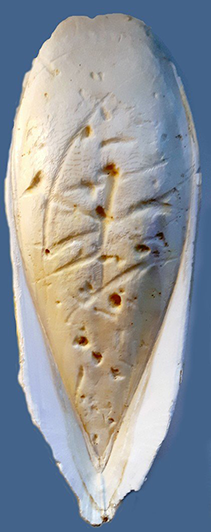Bones of contention
In a fierce rivalry surpassed only by rugby players, Australian waters are home to creatures that are not seen in Aotearoa New Zealand. Or . . . are they? Cephalopod expert, Dr Mandy Reid at the Australian Museum, explores further.
In a world first, DNA has been extracted from beach-washed cuttlebones found on New Zealand shores. While Australia is home to about one third of all known cuttlefish species, no cuttlefishes live around New Zealand. That’s it: zero, zilch.
Through an Australian lens, finding a cuttlebone on a beach is such a common occurrence that it barely raises an eyebrow. But, when New Zealanders (in New Zealand) see a cuttlebone of any sort, whether abraded, broken, or barnacle encrusted, they are treated with a reverence and excitement that is bizarrely unsurpassed. Could it be that whole animal cuttlefishes do live around the ‘land of the long white cloud’ after all?

A Giant Australian cuttlefish, Sepia apama.
Image: Dr Mandy Reid© Dr Mandy Reid
Cuttlefishes, like many inshore cephalopods (the group that also contains squids and octopuses), have relatively short lives and die soon after spawning. When this happens, their bodies and built-in buoyancy devices (the calcareous cuttlebones) float to the ocean surface and are ultimately carried by currents to land, which may be hundreds of kilometres away.
A request from the mollusc curator at the Museum of New Zealand Te Papa Tongarewa, Dr Rodrigo Salvador, to identify some cuttlefish species based on cuttlebones found washed up on beaches in New Zealand, was, for me, a ‘ho hum’ moment (another case of ‘wishful thinking’ perhaps?). That was, until Rodrigo suggested the idea of trying to extract DNA from the cuttlebones to help with the identifications.
This piqued my interest. A number of cuttlefish species have been originally described on the basis of beach-washed cuttlebones alone with no knowledge of the whole animal ‘soft parts’. So, if DNA could be extracted from cuttlebones (something that had not been attempted before) it might help in future to verify the identity of those only partially understood species.

Beach-washed Sepia apama cuttlebone showing various marks made by scavengers. The cuttlebone sits just under the skin on the upper, or dorsal, side of the animal.
Image: Dr Mandy Reid© Dr Mandy Reid
I was able to identify to species, most intact cuttlebones from images sent by Rodrigo (which are diagnostic and specific to cuttlefish species) but for some partial, broken and extensively abraded cuttlebones, I had no clue. The diagnostic features were no longer present. They had clearly been drifting for long distances or time as they were very worn and often barnacle, or hydrozoan jellyfish, encrusted. However, the successful extraction of DNA from some of these cuttlebones did, indeed, assist with species identifications. We were able to compare the DNA obtained from some of these cuttlebones with DNA from whole animals held in the Australian Museum collections to find species matches.
In addition, Rodrigo and colleagues were interested in the scrapings and marks on the bones, or ‘praedichnia’, left by scavengers that must have fed on the soft parts of the cuttlefishes after death and bitten and scraped the cuttlebones. Through careful analyses, comparing shape, size, position of the teeth, gape, and biting force, these were matched to the beaks and tooth marks from various seabirds, fishes and dolphins that inhabit Australia and the Tasman Sea.

Cuttlebone fragments found on beaches in New Zealand showing scavenging marks (red boxes). The holes in the cuttlebone on the far right are an exact match to the teeth of Delphinus delphis Linneaus, 1758, the Short-Beaked Common Dolphin (image of skull below). The narrow punctures in the top left and middle cuttlebones were probably caused by sharks.
Image: Jean-Claude Stahl.© Jean-Claude Stahl.
The results? Until an intact live animal cuttlefish is observed or collected in New Zealand waters, our conclusion remains that due to some unknown vagary of historical biogeography, cuttlefishes definitely do not make New Zealand home. Decades of underwater observations and fishing have never turned up a single one. Cuttlebones from the Australian endemic species, the Giant Australian Cuttlefish, Sepia apama Gray, 1849, the widespread Indo-Pacific species, Sepia latimanus Quoy & Gaimard, 1832 and Sepia grahami Reid, 2001, also from Australia, appear to have drifted on currents to New Zealand.
In addition, prior to or during their journey, the soft parts of these animals have been prey items for albatrosses, sharks and dolphins. It is well known that albatross breeding is linked to the spawning time of the Giant Australian Cuttlefish.
The successful extraction of DNA from cuttlebones has potential for future applications, including the examination of species only known from cuttlebones.
But a word of warning. While coveting cuttlefish species of their own, the introduction of these high trophic level marine carnivorous predators to New Zealand would wreak all sorts of havoc on marine ecosystems. It is better that they stay firmly entrenched where they belong.
Dr Mandy Reid, Collection Manager, Malacology, Australian Museum.
More information
- Battam, H., Richardson, M., Watson, A. W. T. & Buttemer, W. A. (2010). Chemical composition and tissue energy density of the cuttlefish (Sepia apama) and its assimilation efficiency by Diomeda albatrosses. Journal of Comparative Physiology B. 180: 1247–1255.
- Evans, K. 2022. Whose Teeth? New Zealand Geographic. https://www.nzgeo.com/stories/whose-teeth/
- Reid, A. (2016): Post-mortem drift in Australian cuttlefish sepions: its effect on the interpretation of species ranges, Molluscan Research, 36(1): 9–21. http://dx.doi.org/10.1080/13235818.2015.1064366
- Salvador, R. B., Reid A., Shepherd, L. D., Macpherson, D. & Tennyson, A. J. D. (2021): CSI – Cuttlefish Sepion Investigation: overview of cuttlebones found on Aotearoa New Zealand shores and analysis of predation and scavenging marks, New Zealand Journal of Marine and Freshwater Research. https://doi.org/10.1080/00288330.2021.2000439

